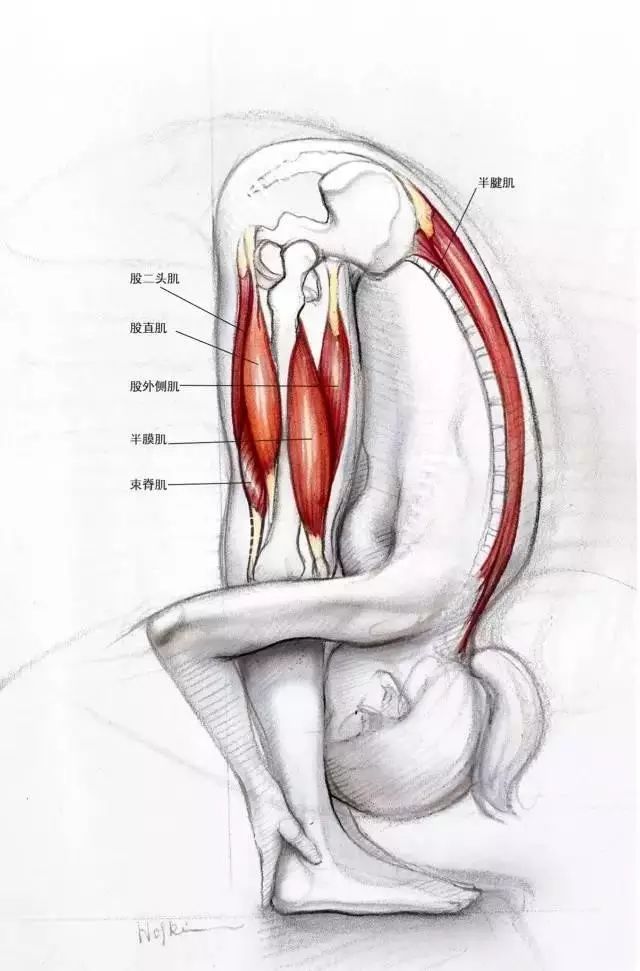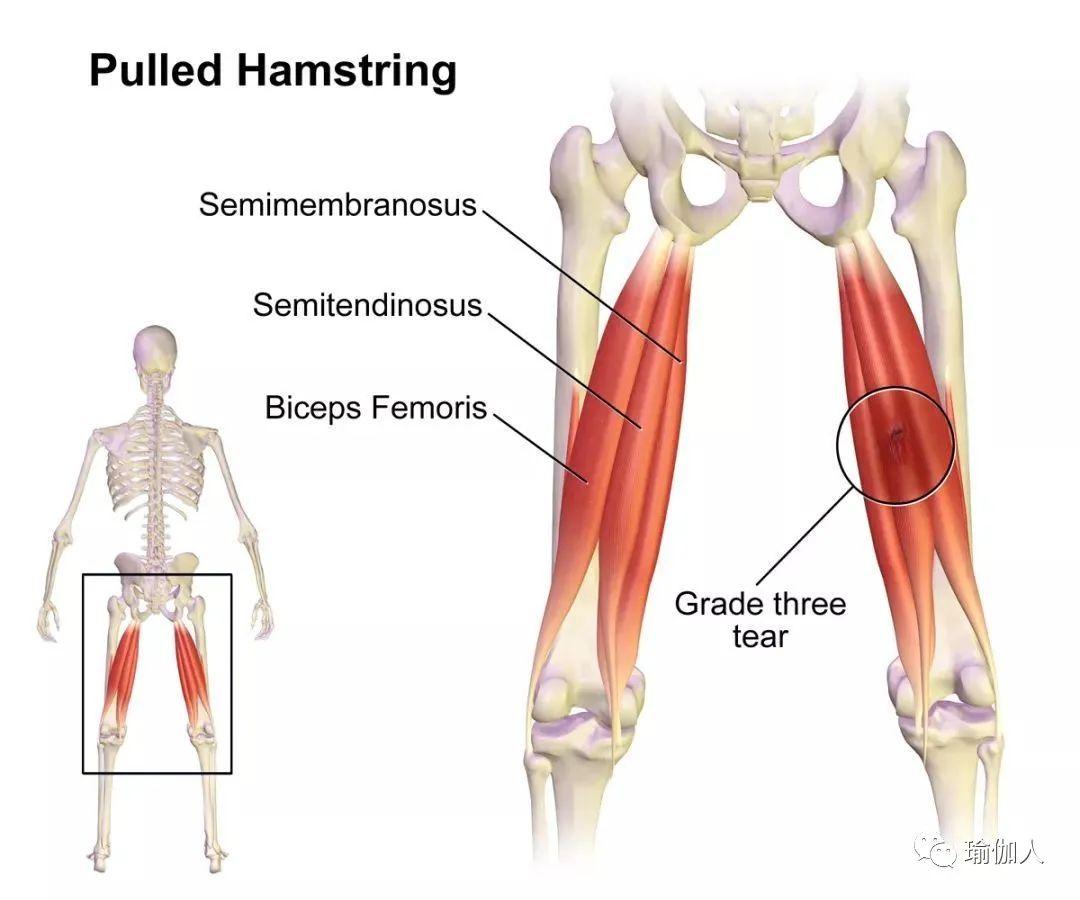There is a problem that many students will encounter when practicing yoga, that is, “the back of the thigh is tight.”
. 
Because the back of the thigh tension and affect the yoga movement, the most typical is the forward bend do not do well
. 
When the body goes down, I feel that the muscles at the back of my thigh are very tight, but I can’t touch the ground with my hands
. 
In fact, the root cause of the above problems may be due to hamstring muscle tension
. 
In yoga, the attendance rate of hamstring is still quite high
. 
Which part of the body is the hamstring? How to use it better! Where are the hamstrings? Hamstring is not a single muscle, but a muscle group at the back of thigh, which is usually composed of semitendinosus, hemimembranous and biceps femoris
.
The common starting point of these muscles is the ischial tubercle of pelvis, which forms antagonistic effect with quadriceps femoris in front of thigh
.
What are the functions of hamstrings? The main function of hamstring is to straighten hip joint and bend knee joint
.
It is an important dynamic stable structure to maintain the stability of knee joint, especially to prevent excessive forward tibial dislocation
.
Therefore, when we have knee problems, we can start from the muscles around the joint to find the root of the problem, relax and repair the damaged part
.
For stiff and sore muscles, what people usually do is stretch, but the inevitable situation in stretching is over stretching, resulting in strain
.
Hamstring strain is an example, whether it is yoga practitioners or athletes, this is an extremely common problem
.
Due to the overuse of muscles and joints, it will cause long-term strain of such muscles and joints
.
The underused muscles will become cumbersome and dull, further affecting the active parts, so that the active parts must bear the additional burden
.
For example, the overuse and overdevelopment of the quadriceps will shorten the hamstring, make the hamstring easy to pull and tear, and make the knee damaged, weak and painful because it can not bear the burden caused by the overdeveloped quadriceps and weak hamstring
.
Most athletes have more developed quadriceps than hamstrings
.
Hamstrings tend to become tense and stiff, easy to get injured
.
The hamstring may tear only because the athlete steps slightly out of his reach
.
Hamstring injury can be divided into I, II and III degrees according to the severity
.
Degree I injury includes slight muscle tear; degree II injury is partial tear of muscle fiber; degree III injury is complete rupture of muscle fiber
.
How to prevent hamstring injury? 1
.
Proper warm-up before exercise is one of the important methods to prevent hamstring injury, and it has been proved that it can effectively reduce the risk of hamstring injury
.
2
.
Muscle strength training for other muscle groups around, including thigh, pelvis and lower waist exercises, to ensure the balance of muscle strength around
.
3
.
Do stretching exercises on both sides to ensure that the muscles on both sides are properly stretched
.
4
.
By distinguishing muscle tension and soft weakness, regular deep tissue Exercise Massage Relaxation, help prevent muscle strain
.
Over stretching can result in a minimally invasive injury or a small tear of a muscle, ligament, tendon, or other soft tissue in the musculoskeletal system
.
After injury, if you continue to stretch, it is difficult to recover, creating lesions for chronic or recurrent inflammation and pain, and the affected tissue is also prone to further tearing
.
If you look at common exercise sequences, it’s easy to overstretch
.
Yoga_ In general, a slight discomfort in the middle of the back thigh muscles does not cause any problems
.
However, if you feel discomfort or pain near the sciatic bone during stretching, or pain after sitting for a long time, especially after sitting in a hard place, you should pay attention to it
.
In this case, if you continue to stretch the hamstring during practice, it will cause slight tears and pain inflammation, which will make the hamstring more painful after practice
.
If you suspect that you are stretching too much, pulling or tearing your hamstring, it’s time to change your practice now to avoid repeated injuries for a long time and promote healing
.
The change may be obvious now, that is, you have to stop stretching your hamstrings, maybe for a few weeks, if it’s a serious injury, maybe for a few months
.
Yoga practitioners often object to stopping stretching the hamstrings, but in fact, you just need to give these tissues time to heal without making the problem chronic or recurrent
.
However, you don’t need to stop Yoga altogether: for example, you can practice postures that increase upper body strength or quadriceps flexibility, or focus on breathing control
.
Once the tear is healed, which means there is little or no pain for a week or two, you can gradually return to stretching
.
The hamstring is not injured, but it’s stiff
.
It’s a soothing pose through yoga! Description of standing mountain posture: the legs are the same width as the hips, the toes and heels keep in a straight line, the kneecap is raised, the pelvis keeps in a plane, the core muscles are contracted, the internal bone is adducted, the shoulders are sunk, and the neck extension line is extended
.
Both arms are on the side of the body
.
Action effect: stimulate the hamstring muscle to stretch and adjust the unbalanced strength on both sides of the body
.
Lotus sit to use blanket to assist pelvis and knee, long sit to bend one knee, put a towel or auxiliary belt around the knee from below, and grasp both ends of towel or extension belt with the same hand
.
Pull up and out
.
Objective: turn the thigh outward and open the inside of the knee, and continue to do this action until the foot on the bending side can be raised and placed on the opposite thigh with the help of the other hand, and close to the abdomen
.
If there is discomfort in the knee, stop immediately
.
Sit just below your hips and try to keep your heels as high as possible
.
The knees are slightly apart and the thigh bones are parallel
.
The direction of the tip of the foot and the calf in a straight line, sitting like this for a few minutes every day, can alleviate the pain of the hamstring
.
In the process of hamstring recovery, you can start stretching every other day (once a week is not enough for strength)
.
Strengthening strength will promote blood circulation, and good blood circulation will promote healing and make the tissue more healthy and elastic
.
However, if there is pain, it indicates that the soft tissue inflammation is more serious, can not load, load will further stimulate it
.
In this case, you may have to wait a little longer to start strength training..
.

